Campo de Hielo Norte & Sur - Le grand voyage
Forty five days to traverse a large portion of the two biggest ice fields in Patagonia—a 600km journey.
By Rolando Garibotti, 14/01/2023.
- Versión en español
[This article is copyrighted. Please do not reprint this article in whole or part, in any form, without obtaining written permission.]
Over forty-five days between late October and mid-December 2022, five French alpinists and skiers, completed an unprecedented traverse linking large portions of the two biggest ice-fields of southern Patagonia, the Campo de Hielo Norte and the Campo de Hielo Sur, covering 600km of glaciated, at times jagged cordillera.
The five alpinists and skiers are Thomas Auvaro, Léo Billon, Didier Jourdain, Christophe Malangé and Jordi Noguere. They are part of the Groupe Militaire de Haute Montagne (GMHM), an elite French mountaineering military group that was established in 1976. This group has made giant steps to push the sport, carrying out impressive expeditions all over the world, from the North Pole, to the Himalaya, Antarctica, by way of the Alps and Yosemite
Didier thought of trying this project a few years ago when he was flying over the area coming back from an expedition in Antarctica. The original idea dates to 1993, to Swiss alpinists Franco Dellatorre and Arturo Giovanoli.
They spent two years planning and training for the trip, including a one month reconnaissance in October 2021. Jacques-Olivier Chevallier was supposed to be part of the team too, but two days before departing he suffered appendicitis that forced him out of the trip.
They started from Lago Leones, reaching the plateau of the Campo de Hielo Norte via the Cristal / Mocho col. Due to committing to do the traverse without using caches or resupply, they initially had 100 to 105 kilos each. This meant that in the first few days, until they were able to start pulling sleds, they had to porter four times, taking 25kg loads at the time.
In the Hielo Norte they had six days of good weather, which although welcome and enjoyable—never expected even in a dream, meant little wind, so they were unable to use their kites. In spite of this, on one of the days they covered 40km. They pushed hard those first few days because they knew a low pressure was coming, and wanted to pass the Paso Colonial over Cordón Aysen with good visibility (the ascent to the pass is heavily crevassed and has many seracs).
Later their weather luck would turn. During the entire traverse of the Campo de Hielo Sur, close to 30 days, they only had two and a half days of good weather.
They exited the Campo de Hielo Norte via Glaciar Steffen, initially via the center, then past a couple of kilometers of sharp ice ridges, to reach the left bank. This section required five days, taking triple loads through the moraines and ice ridges, followed by a half day pack-rafting for 20km down the Río Huemules to fjord Steffen and Canal Baker on the Pacific Ocean.
Continuing with the pack-rafts they then spent four days to cover 100km of open water to the start of Glaciar Jorge Montt. They wore dry suits and flotation vests. On one 4km open crossing they were caught by bad weather, and had to stay focused to keep the situation under control, avoiding their rafts taking too much water and or flipping over.
On the coast, and near the front of the Jorge Montt glacier they left all of their water gear, including their pack-rafts, paddles, dry-suits and life vests, which were later picked up by a boat.
The route up the Jorge Montt glacier was crucial in the success of the trip. This section is notorious for having taken as many as two weeks for other teams. Instead of ascending the left bank (west), they ascended the right bank, taking a side valley to the east leading to a pass. In two days they reached the first glacier, and in another half day the glacial plateau.
They were then able to kite much of the northern part of the Campo de Hielo Sur. They followed a track that they had researched using satellite and aerial images. At times while kiting the visibility was down to 30 meters, and they had to trust their track blindly.
Permit constraints forced the group to avoid the border area that is disputed with Argentina. This meant that after passing Volcán Lautaro they headed west, to Paso de los Cuatro Glaciares and Altiplano Caupolicán, west of Cordón Mariano Moreno. This is a far more complex route than if they had been able to stay on the east side. Due to high winds, and after 27 days they took their first rest day. They rested right before Paso Rokko (2100m approx), a far from straight forward pass in the “geopolitically forced” western route they had to follow.
They arrived at the Falla Reichert after 32 days, on the 30th of November. They managed to descend in a single day choosing the safest possible line, that is nonetheless exposed to massive seracs. To pass this technical section they had to set up several Tyrolleans for their sleds, which now weighed around 60kg.
The Falla is a gap in the ice field, and for this reason it creates its own weather with a strong Venturi effect.
On the opposite side, not far from the summit of Cerro Bastion, they were caught by a fierce storm and decided to wait for better weather. The descent from Bastion is technical and dangerous, so they knew decent conditions were needed to ensure safety. For five days they holed themselves up in a snow cave while it raged outside.
On day 38, when a short lull appeared in the forecast they got going. The ascent up Bastion is fairly straight forward, a glacier with a steep ice section. But it was there that lightning struck. Christophe slipped five meters while traversing a sharp ice ridge, and on landing broke his hip. Initially they feared a pelvis fracture, with potential for internal bleeding, but luckily that was not the case. The next morning, and thanks to a four hour opening in the weather, a helicopter from the Chilean company DAP was able to pick him up. Because of the wind it was touch and go, and it was not until the helicopter was in the air, flying away, that they could take a breath of relief. They had estimated that a rescue by foot to the west, down to the sea, carrying Christophe in a makeshift stretcher would have taken seven to ten days.
After the helicopter flew off they all gathered in one tent to discuss openly what to do. In spite of being shaken, they decided to continue ahead, climbing to the summit of Cerro Bastion that very day. The issue is that the brief weather window that they had planned to use to do the treacherous descent off Bastion, had been dedicated to the rescue. The next day they sat waiting for an improvement, but on day 41 they realized they could not wait any longer, it was now or never.
The descent was epic. There was no visibility, so they did not know where they were in relation to the dangerous seracs. Their clothing was covered by two centimeters of rime, and at times they had to do 120m long rappels, with 40 meter overhanging sections over massive ice features. All this while carrying 60 kg sleds hanging from their harnesses. On top of that the slope was loaded and the fear of an avalanche was constantly present. This long meandering day ended at 10:30pm, and they only managed to fall asleep at 3:30am after recovering and fixing a broken tent.
The next day they started late, but made good progress towards Glaciar Grey, which they reached after a very long effort the following day (day 43).
By now they had six days of food left. They were at 1400m and the wind was blowing at 80km/h. The forecast for the following days was terrible and reaching Glaciar Tyndall or Glaciar Balmaceda seemed implausible. The group were still shaken by the accident, and also grateful how everything had worked out. They decided to head out from that point.
On day 44 they worked their way on the left bank (east) of the Glaciar Grey, negotiating a long section of sharp ice ridges, and after 16 hours reached the hut below Garner Pass.
The next morning they walked down to the lake where they were picked up by a boat. Here they were met by Jacques-Olivier, their partner and friend that had been forced out of the trip at the last minute due to appendicitis. It was very emotional. Within three or four days they were on their way home, to celebrate Christmas with their respective families.
To avoid the pitfalls of external pressure they chose not to do any big press releases prior to the trip or communicate any updates during the expedition. The magnitude of the objective required a cautious approach.
This was a very intense trip, done during what weather wise was a particularly challenging late Spring. It was a massive adventure that combined an infinite number of variables and unknowns, the mental and physical demands of a long traverse, with technical sections that require fine tuned alpinism skills, boating sections where no mistakes can be made, all in the most unforgiving of environments.
Thomas, Leo, Didier, Christophe and Jordi handled it all with impressive mastery, including an accident that could have had dire consequences. One has to imagine that the ocean of emotions that they experienced during these 45 days must have yield a lot of richness and personal growth, an expanse as lengthy and broad as the impressive 600km of cordillera they covered.
|
Photos (click to enlarge)
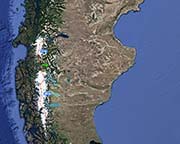
The line followed. Click to enlarge.
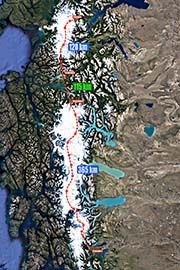
The line followed. Click to enlarge.
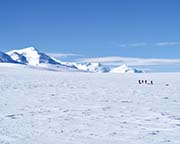
In the inmensity. Click to enlarge.
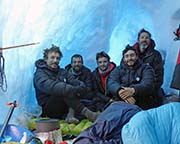
The team. Click enlarge.
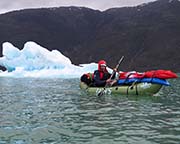
In the Canal Baker. Click to enlarge.
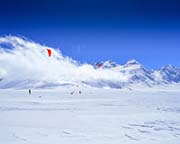
In the inmensity. Click to enlarge.
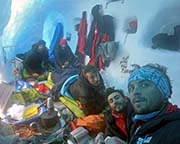
The team. Click to enlarge.
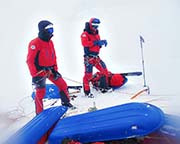
Descending Reichert. Click enlarge.
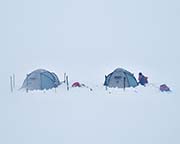
Camp. Click to enlarge.

Descending Bastion. Click to enlarge.
|
Addendum Gear.
They used carbon fiber ski touring race boots, made by Pierre Gignoux, a small outfit in France, combined with Intuition liners and a specially made gaiter.
They used light racing skis from Ski Trab: Gara World Cup in 162cm length; with Plum Race R170 bindings.
They used single wall tents, with thicker poles than usual that were designed specially for the trip, but will be commercialized by the manufacturer, Samaya, from Annecy.
The sleeping bags used were Barbat 500 from the French brand Triple Zero, with an extra 100 grams of down (600 grams of 800-fill-power down in all). On top they added a Primaloft over from the brand Carinthia.
They took two 60m Petzl Rad Lines (6mm), and one 120m 5mm rope.
They used MSR XGK stoves, taking 170 ml of fuel per person per day (10.2 liters per person when they started, planning for 60 days), but because they were able to find quite a bit of water, they used less fuel than expected. This allowed them to often use warm bottles to dry their clothing or sleeping bag.
They had two sleds each, a full size one, and a front half piece. Initially this allowed them to divide the load into two sleds, later they combined both pieces, side by side into one sled, in such a way so they could not roll over while kiting.
They carried 60 days of food, 45 of them were 900 grams and offered 4000 calories, while the remaining 15 were 500 grams and had only 2000 calories. All of them lost a lot of weight, some as many as eight kilos.
Addendum previous traverses
The original idea of connecting the two ice fields dates back to 1993, to the Swiss mountaineers Franco Dellatorre and Arturo Giovanoli. Together with Romolo Nottaris and after ascending Cerro San Valentín, they crossed the Campo de Hielo Norte starting from Laguna San Rafael, taking 14 days. Then they transferred by boat to the Jorge Montt glacier, from where Franco and Arturo continued alone. They reached the area of the Falla Reichert, from where, due to an accident, they had to give up. Two weeks later and by their own means, they managed to exit via Estancia Cristina.
There have been several crossings of much of the Campo de Hielo Sur. The main ones are the following.
In 1992, Spaniards José Carlos Tamayo, Antonio Trabado and José Luis Fernández, and the Swiss/Argentine Sebastián de la Cruz started via the Jorge Montt Glacier, reaching the Falla Reichert, which they crossed by helicopter, continuing south to exit via the Tyndall Glacier.
Over 98 days in late 1998 and early 1999, Chileans Pablo Besser, Rodrigo Fica, José Montt and Mauricio Rojas, started via the Jorge Montt Glacier to reach the Falla Reichert which they negotiated by their own means, continuing south to exit via the Balmaceda Glacier reaching the Seno de la Última Esperanza. They relied on an intermediate deposit in the area of the Falla Reichert.
Over 53 days between the end of August and the beginning of October 2003, Norwegian Börge Ousland and Swiss Thomas Ulrich left Caleta Tortel by kayak, headed for the Jorge Montt glacier, traversed the Ice Field to the Falla Reichert, negotiated it, and continued south exiting through the Tyndall glacier, reaching Puerto Natales by kayak. They made this traverse without any intermediate caches.
|









